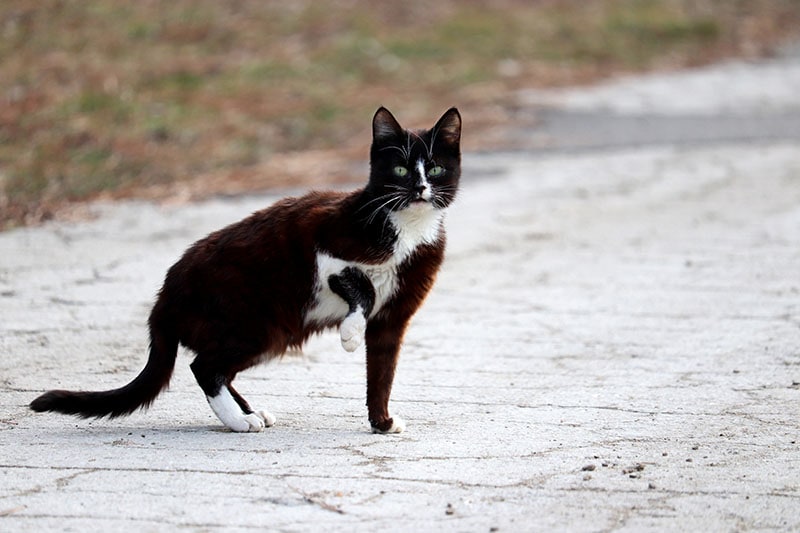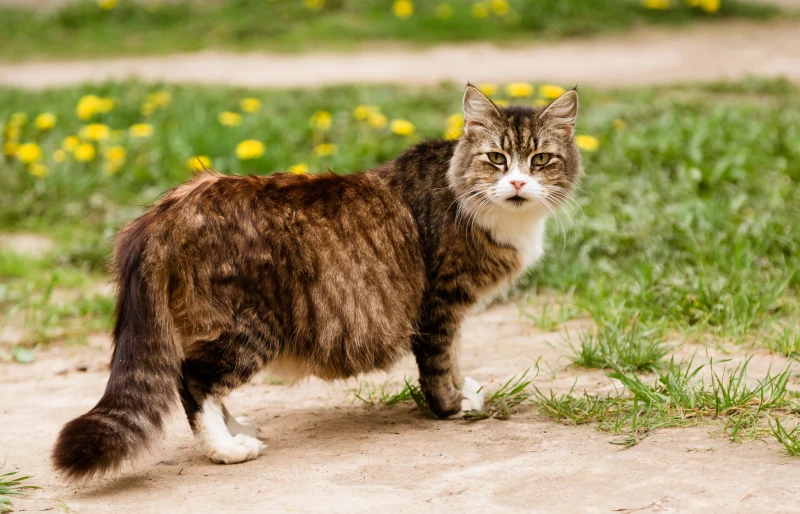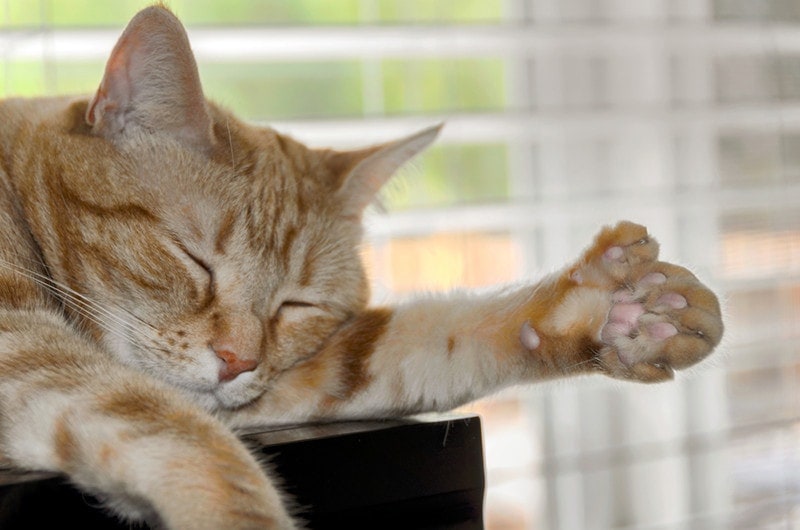
Most of us know the saying, “Cats have nine lives.” We don’t know where or when this term exactly originated from, but perhaps it’s to do with the fact that cats are extremely independent, curious and seem to have an incredible knack for escaping injury. They can fall from heights and land square on their paws, move like lightning when they perceive danger, and nonchalantly balance along rooftops and fences.
However, although they are brilliantly agile creatures, their little legs are not immune from pain. In fact, limping is one of the more common problems seen in the veterinary office.
There are many causes of lameness in cats. Some are more serious than others, and if you ask yourself, “Should I take them to the vet to get checked out?” then the answer is most likely “yes.” So, what are some reasons why your cat could be limping?
The 7 Reasons Why My Is Cat Limping
1. Sprained or Pulled Muscle
A sprain or muscle tear in cats, or what we term soft tissue trauma, is a common injury in cats. Muscles are made of fibers, and if they are stretched beyond their normal range, these fibers can tear, causing pain. It usually causes a varying degree of lameness (mild or severe, depending on the severity of the muscle tear).
How Is Soft Tissue Trauma Treated?
A muscle pull or sprain is normally treated with rest and anti-inflammatories. Sometimes, depending on the injury, your veterinarian will recommend other treatment modalities like physiotherapy and laser therapy. The time of rest will depend on the severity of the strain. If the tear is severe, surgery may be required.

2. Cat Fight Abscess or Bite Wound
A cat fight abscess is an injury we commonly see in cats that have access to the outdoors and have contact with other cats. They are territorial creatures; they like their own company and space and are not particularly tolerant of other species encroaching upon their space. Cats carry particularly nasty bacteria in their mouths and claws, and when this penetrates through the skin, a nasty infection can form, often resulting in an abscess. This is painful, often resulting in a cat not wanting to bear weight on the affected leg. Other signs of a cat fight abscess include fever, lethargy, poor appetite, and just generally being off-color.
How Are Cat Fight Abscesses Treated?
Cat fight abscesses mostly require treatment with antibiotics and anti-inflammatories. Sometimes your cat will need to be sedated and the abscess lanced and flushed surgically. Any outdoor cat with contact with other cats is at risk of a cat fight abscess, so it is important to ensure that they are up to date with their vaccinations.
3. Fractured Bone or Dislocation
Although cats are agile and mostly graceful creatures, their bones can break or slip out of place. Injuries like this normally happen after falling from a height, getting hit by a car, being stepped on, or being attacked by a dog or other animal. A broken bone or dislocated joint will result in significant pain that mostly has your cat refusing to bear weight on the affected leg.
How Are Broken Bones Treated?
The kind of physical forces exerted on the bone results in different types of fractures. This means that treatment for fractures and dislocations depends on the bone that was broken and the type of break that occurred. Fractures can be placed in a splint or cast (used less commonly in cats); they may require orthopedic surgery or may be able to heal with a period of cage rest where movement is severely restricted. Sometimes, amputation may be the best option in severe fractures.

4. Torn, Infected or Ingrown Nail
A tiny nail can be a big, painful problem, particularly as cats age and become more sedentary. Cats normally keep on top of the length of their claws themselves, removing the old outer layers of the claw by sharpening it against their scratching post, or our expensive pieces of furniture! However, as they become older and less mobile, this becomes less of a priority for cats, and their claws can grow too long, sometimes curling right around into their paw pad. This is obviously very painful and can result in an infection of the paw pad if it goes unnoticed. They can also get their claws caught, causing them to split or detach from the nail bed.
How Are Torn or Ingrown Nails Treated?
If your cat’s claws grow too long, it’s important to ensure that you get them routinely clipped to stop any secondary trauma to the paw pad. If the nail has torn because of trauma, the entire claw may need to be removed. If nail problems are a continuous issue, then any underlying disorders, such as arthritis or nail bed infections, will need to be ruled out.
5. Foreign Object in Paw
Outdoor cats that have the propensity to roam and explore are prone to getting foreign objects in their paws. Grass seeds, thorns, splinters, and glass can track underneath the skin and dig their way in between the paw pads, causing an immense amount of discomfort. It can often be difficult to find a foreign object once it has burrowed under the skin, but no matter how small it is, it can be a very large discomfort for your cat.
How Are Foreign Objects in Paws Treated?
If it is suspected that there is a foreign body in your cat’s paw, it will need to be surgically explored and removed. It can be difficult to find a small object in the soft tissue of the paw or leg. If unsuccessful and your cat is having continuous problems or not responding to treatment, they may need further diagnostic imaging to find it, such as a CT, to rule it out once and for all.

6. Arthritis
Arthritis is a common condition described in dogs, but in cats, it is often overlooked. Researchers believe that 90% of cats over the age of ten are affected by arthritis to some degree. This only supports the fact that we need to be more considerate of what pain truly looks like in our feline companions, so that we can make their lives as comfortable as possible.
Cats may limp with arthritis, but because arthritis can affect multiple joints on all legs, you may find it more of a shuffling lameness or stiffness. Sometimes they may not limp at all, and the signs may be more subtle. You may notice some difficulty jumping up onto heights, hesitation moving upstairs, slowing down, or simply a lack of grooming and self-care.
How Is Arthritis Treated?
Arthritis treatment is tailored to a patient’s specific needs and requirements. Fortunately, there are many different options for the management of arthritis, including anti-inflammatories, joint supplements, weight management diets, laser therapy, antibody-type injections, acupuncture, and further intensive pain relief drugs. Arthritis is a condition that needs long-term care. However, with appropriate treatment, patients can still have a good quality of life.
7. Other Illnesses
More rarely, lameness can be a result of a more serious underlying issue, such as an autoimmune condition, a tumor, or an aortic thromboembolism.
An aortic thromboembolism most commonly causes sudden paralysis of the hindlimbs, resulting from a blood clot in the spine that blocks the blood supply to the back legs. The clot forms as a consequence of underlying heart disease, which is why your cat’s annual health checks are so important. Your veterinarian will be able to catch any changes in your cat’s heart early, hopefully preventing an aortic thromboembolism which is often fatal.

Questions to Ask About Your Limping Cat
If you are unsure whether your cat is sore or not, or you’re questioning whether they are limping at all, there are a few questions you can ask yourself:
Conclusion
If you are concerned about your cat’s sore leg, then it may be time for a trip to your veterinarian. Cats are biologically designed to mask pain. If they are clearly demonstrating to you that they are limping and sore, then it is time to find out why. Seeking appropriate care gives them a better chance of responding to treatment, no matter what the cause is.
Featured Image Credit: lagunabluemolly, Pixabay







